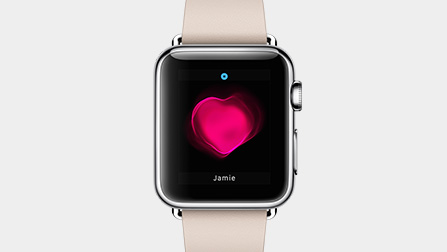Dexcom is using the soon-to-be released Apple Watch for its wearable glucose monitor.

The Apple Watch showing a heartbeat. (Image courtesy of Apple)
Nancy Crotti
In the highly competitive, continuous-glucose-monitoring device market, Dexcom (NASDAQ: DXCM) is leaping ahead with an app that will display readings on Apple’s smartwatch, due out in April.
The readings from Dexcom’s wearable glucose monitor will appear as an easy-to-read graph on the Apple Watch, according to a report in the Wall Street Journal. Apple declined comment, but announced in November that it is making tools available to developers to design apps for the watch.
The news should be particularly exciting for Type 1 diabetes patients and their families, who often struggle to track children’s glucose levels, particularly overnight. A frustrated group of software engineers, many of whom have children with Type 1 diabetes, developed an online system to monitor blood glucose in 2013. The group, identified by the name NightScout and using the hashtag #wearenotwaiting, challenged the slow pace of diabetes technology innovation and approval, while highlighting the growing role of continuous health monitoring by medtech companies and software developers, the Journal report said.
Dexcom is benefiting from FDA’s recent loosening of regulation over software. While the agency still considers glucose monitors (including the recently approved G4 PLATINUM Continuous Glucose Monitoring System) Class III devices, it now requires medtech companies to register apps for mobile devices rather than seeking PMAs.
The G4 Platinum deploys a hair’s-width sensor under the skin to measure blood-glucose levels every five minutes. Its Share receiver uses a secure wireless connection via Bluetooth Low Energy (BLE) between a patient's receiver and an app on the patient's smartphone to transmit blood glucose levels to apps on the mobile devices of up to five designated “followers” without the need for a dedicated docking cradle, the company explained. These followers can remotely monitor a patient's glucose information and receive alerts, initially via their iPhone or iPod touch, and in the future on Android devices, Dexcom said. The "Share" and "Follower" apps will be available on the Apple App Store at no charge.
BLE may be enabling the digital health revolution. Qualcomm Life, a subsidiary of the San Diego–based communications giant, announced last year that its 2net Hub, a plug-and-play home gateway for health monitoring devices, became one of the first hubs that is both an FDA Class I medical device and is able to communicate with devices over Bluetooth Smart.
In the diabetes world, Dexcom intends to introduce a “stead stream” of sensor-related products, reported Zacks.com. Dexcom anticipates 2015 revenues of $340–$360 million, the stock-watching website added.
“We believe Dexcom will continue to generate significant top-line growth on the back of strong performance by G4 Platinum coupled with innovative product launches,” the Zacks report said.
Despite its advances, Dexcom faces stiff competition from Johnson & Johnson, Abbott Laboratories, and Medtronic, all of which make continuous glucose monitors.





